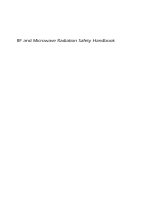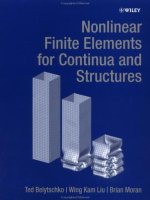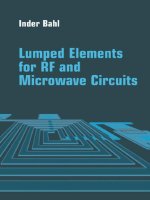Lumped Elements for RF and Microwave Circuits phần 1 pdf
Bạn đang xem bản rút gọn của tài liệu. Xem và tải ngay bản đầy đủ của tài liệu tại đây (9.76 MB, 50 trang )
Lumped Elements for RF
and Microwave Circuits
For a listing of recent titles in the Artech House Microwave Library,
turn to the back of this book.
Lumped Elements for RF
and Microwave Circuits
Inder Bahl
Artech House
Boston
•
London
www.artechhouse.com
Library of Congress Cataloging-in-Publication Data
Bahl, I. J.
Lumped elements for RF and microwave circuits / Inder Bahl.
p. cm. — (Artech House microwave library)
Includes bibliographical references and index.
ISBN 1-58053-309-4 (alk. paper)
1. Lumped elements (Electronics) 2. Microwave integrated circuits. 3. Radio
frequency integrated circuits. 4. Passive components. I. Title. II. Series.
TK7874.54.B34 2003
621.381’32—dc21 2003048102
British Library Cataloguing in Publication Data
Bahl, I. J. (Inder Jit)
Lumped elements for RF and microwave circuits. — (Artech House microwave library)
1. Radio circuits 2. Microwave circuits I. Title
621.3’8412
ISBN 1-58053-309-4
Cover design by Igor Valdman
2003 ARTECH HOUSE, INC.
685 Canton Street
Norwood, MA 02062
All rights reserved. Printed and bound in the United States of America. No part of this book
may be reproduced or utilized in any form or by any means, electronic or mechanical, including
photocopying, recording, or by any information storage and retrieval system, without permission
in writing from the publisher.
All terms mentioned in this book that are known to be trademarks or service marks have been
appropriately capitalized. Artech House cannot attest to the accuracy of this information. Use
of a term in this book should not be regarded as affecting the validity of any trademark or service
mark.
International Standard Book Number: 1-58053-309-4
Library of Congress Catalog Card Number: 2003048102
10987654321
To my adorable grandsons, Karan and Rohan Kaushal, with whom I play, cry,
and laugh, and who have provided me with the idea and inspiration to
write this book
Contents
Preface xvii
Acknowledgments xix
1 Introduction 1
1.1 History of Lumped Elements 1
1.2 Why Use Lumped Elements for RF and
Microwave Circuits? 2
1.3 L, C, R Circuit Elements 4
1.4 Basic Design of Lumped Elements 6
1.4.1 Capacitor 7
1.4.2 Inductor 8
1.4.3 Resistor 8
1.5 Lumped-Element Modeling 9
1.6 Fabrication 11
1.7 Applications 12
References 13
2 Inductors 17
2.1 Introduction 17
vii
viii Lumped Elements for RF and Microwave Circuits
2.2 Basic Definitions 18
2.2.1 Inductance 18
2.2.2 Magnetic Energy 18
2.2.3 Mutual Inductance 20
2.2.4 Effective Inductance 20
2.2.5 Impedance 21
2.2.6 Time Constant 21
2.2.7 Quality Factor 22
2.2.8 Self-Resonant Frequency 23
2.2.9 Maximum Current Rating 23
2.2.10 Maximum Power Rating 23
2.2.11 Other Parameters 23
2.3 Inductor Configurations 24
2.4 Inductor Models 25
2.4.1 Analytical Models 25
2.4.2 Coupled-Line Approach 28
2.4.3 Mutual Inductance Approach 34
2.4.4 Numerical Approach 36
2.4.5 Measurement-Based Model 38
2.5 Coupling Between Inductors 45
2.5.1 Low-Resistivity Substrates 45
2.5.2 High-Resistivity Substrates 46
2.6 Electrical Representations 50
2.6.1 Series and Parallel Representations 50
2.6.2 Network Representations 51
References 52
3 Printed Inductors 57
3.1 Inductors on Si Substrate 58
3.1.1 Conductor Loss 60
3.1.2 Substrate Loss 63
3.1.3 Layout Considerations 64
3.1.4 Inductor Model 65
3.1.5 Q-Enhancement Techniques 69
3.1.6 Stacked-Coil Inductor 80
3.1.7 Temperature Dependence 84
ix
Contents
3.2 Inductors on GaAs Substrate 86
3.2.1 Inductor Models 87
3.2.2 Figure of Merit 88
3.2.3 Comprehensive Inductor Data 88
3.2.4 Q-Enhancement Techniques 104
3.2.5 Compact Inductors 112
3.2.6 High Current Handling Capability Inductors 116
3.3 Printed Circuit Board Inductors 118
3.4 Hybrid Integrated Circuit Inductors 121
3.4.1 Thin-Film Inductors 121
3.4.2 Thick-Film Inductors 124
3.4.3 LTCC Inductors 126
3.5 Ferromagnetic Inductors 127
References 129
4 Wire Inductors 137
4.1 Wire-Wound Inductors 137
4.1.1 Analytical Expressions 137
4.1.2 Compact High-Frequency Inductors 144
4.2 Bond Wire Inductor 146
4.2.1 Single and Multiple Wires 147
4.2.2 Wire Near a Corner 150
4.2.3 Wire on a Substrate Backed by a Ground Plane 151
4.2.4 Wire Above a Substrate Backed by a Ground
Plane 153
4.2.5 Curved Wire Connecting Substrates 154
4.2.6 Twisted Wire 155
4.2.7 Maximum Current Handling of Wires 155
4.3 Wire Models 156
4.3.1 Numerical Methods for Bond Wires 156
4.3.2 Measurement-Based Model for Air Core
Inductors 156
4.3.3 Measurement-Based Model for Bond Wires 158
4.4 Magnetic Materials 160
References 161
x Lumped Elements for RF and Microwave Circuits
5 Capacitors 163
5.1 Introduction 163
5.2 Capacitor Parameters 165
5.2.1 Capacitor Value 165
5.2.2 Effective Capacitance 166
5.2.3 Tolerances 166
5.2.4 Temperature Coefficient 166
5.2.5 Quality Factor 167
5.2.6 Equivalent Series Resistance 167
5.2.7 Series and Parallel Resonances 167
5.2.8 Dissipation Factor or Loss Tangent 170
5.2.9 Time Constant 170
5.2.10 Rated Voltage 170
5.2.11 Rated Current 170
5.3 Chip Capacitor Types 171
5.3.1 Multilayer Dielectric Capacitor 171
5.3.2 Multiplate Capacitor 172
5.4 Discrete Parallel Plate Capacitor Analysis 173
5.4.1 Vertically Mounted Series Capacitor 173
5.4.2 Flat-Mounted Series Capacitor 176
5.4.3 Flat-Mounted Shunt Capacitor 177
5.4.4 Measurement-Based Model 178
5.5 Voltage and Current Ratings 181
5.5.1 Maximum Voltage Rating 181
5.5.2 Maximum RF Current Rating 181
5.5.3 Maximum Power Dissipation 182
5.6 Capacitor Electrical Representation 185
5.6.1 Series and Shunt Connections 185
5.6.2 Network Representations 187
References 188
6 Monolithic Capacitors 191
6.1 MIM Capacitor Models 192
6.1.1 Simple Lumped Equivalent Circuit 193
xi
Contents
6.1.2 Coupled Microstrip-Based Distributed Model 194
6.1.3 Single Microstrip-Based Distributed Model 198
6.1.4 EC Model for MIM Capacitor on Si 202
6.1.5 EM Simulations 204
6.2 High-Density Capacitors 206
6.2.1 Multilayer Capacitors 208
6.2.2 Ultra-Thin-Film Capacitors 211
6.2.3 High-K Capacitors 212
6.2.4 Fractal Capacitors 212
6.2.5 Ferroelectric Capacitors 214
6.3 Capacitor Shapes 216
6.3.1 Rectangular Capacitors 217
6.3.2 Circular Capacitors 218
6.3.3 Octagonal Capacitors 218
6.4 Design Considerations 220
6.4.1 Q-Enhancement Techniques 220
6.4.2 Tunable Capacitor 223
6.4.3 Maximum Power Handling 223
References 227
7 Interdigital Capacitors 229
7.1 Interdigital Capacitor Models 230
7.1.1 Approximate Analysis 230
7.1.2 J-Inverter Network Equivalent Representation 235
7.1.3 Full-Wave Analysis 236
7.1.4 Measurement-Based Model 238
7.2 Design Considerations 239
7.2.1 Compact Size 239
7.2.2 Multilayer Capacitor 241
7.2.3 Q-Enhancement Techniques 244
7.2.4 Voltage Tunable Capacitor 247
7.2.5 High-Voltage Operation 249
7.3 Interdigital Structure as a Photodetector 249
References 251
xii Lumped Elements for RF and Microwave Circuits
8 Resistors 253
8.1 Introduction 253
8.2 Basic Definitions 255
8.2.1 Power Rating 255
8.2.2 Temperature Coefficient 256
8.2.3 Resistor Tolerances 256
8.2.4 Maximum Working Voltage 256
8.2.5 Maximum Frequency of Operation 257
8.2.6 Stability 257
8.2.7 Noise 257
8.2.8 Maximum Current Rating 257
8.3 Resistor Types 257
8.3.1 Chip Resistors 258
8.3.2 MCM Resistors 258
8.3.3 Monolithic Resistors 258
8.4 High-Power Resistors 265
8.5 Resistor Models 267
8.5.1 EC Model 268
8.5.2 Distributed Model 269
8.5.3 Meander Line Resistor 270
8.6 Resistor Representations 272
8.6.1 Network Representations 272
8.6.2 Electrical Representations 272
8.7 Effective Conductivity 274
8.8 Thermistors 276
References 276
9 Via Holes 279
9.1 Types of Via Holes 279
9.1.1 Via Hole Connection 279
9.1.2 Via Hole Ground 281
9.2 Via Hole Models 282
9.2.1 Analytical Expression 283
xiii
Contents
9.2.2 Quasistatic Method 284
9.2.3 Parallel Plate Waveguide Model 286
9.2.4 Method of Moments 287
9.2.5 Measurement-Based Model 289
9.3 Via Fence 290
9.3.1 Coupling Between Via Holes 293
9.3.2 Radiation from Via Ground Plug 293
9.4 Plated Heat Sink Via 294
9.5 Via Hole Layout 294
References 296
10 Airbridges and Dielectric Crossovers 299
10.1 Airbridge and Crossover 299
10.2 Analysis Techniques 301
10.2.1 Quasistatic Method 301
10.2.2 Full-Wave Analysis 306
10.3 Models 308
10.3.1 Analytical Model 308
10.3.2 Measurement-Based Model 310
References 315
11 Transformers and Baluns 317
11.1 Basic Theory 318
11.1.1 Parameters Definition 318
11.1.2 Analysis of Transformers 319
11.1.3 Ideal Transformers 322
11.1.4 Equivalent Circuit Representation 323
11.1.5 Equivalent Circuit of a Practical Transformer 325
11.1.6 Wideband Impedance Matching Transformers 326
11.1.7 Types of Transformers 329
11.2 Wire-Wrapped Transformers 329
11.2.1 Tapped Coil Transformers 329
11.2.2 Bond Wire Transformer 332
11.3 Transmission-Line Transformers 332
xiv Lumped Elements for RF and Microwave Circuits
11.4 Ferrite Transformers 336
11.5 Parallel Conductor Winding Transformers on Si
Substrate 339
11.6 Spiral Transformers on GaAs Substrate 341
11.6.1 Triformer Balun 344
11.6.2 Planar-Transformer Balun 345
References 349
12 Lumped-Element Circuits 353
12.1 Passive Circuits 353
12.1.1 Filters 353
12.1.2 Hybrids and Couplers 356
12.1.3 Power Dividers/Combiners 370
12.1.4 Matching Networks 372
12.1.5 Lumped-Element Biasing Circuit 377
12.2 Control Circuits 380
12.2.1 Switches 381
12.2.2 Phase Shifters 387
12.2.3 Digital Attenuator 390
References 392
13 Fabrication Technologies 395
13.1 Introduction 395
13.1.1 Materials 396
13.1.2 Mask Layouts 401
13.1.3 Mask Fabrication 401
13.2 Printed Circuit Boards 402
13.2.1 PCB Fabrication 404
13.2.2 PCB Inductors 405
13.3 Microwave Printed Circuits 405
13.3.1 MPC Fabrication 407
13.3.2 MPC Applications 408
13.4 Hybrid Integrated Circuits 410
13.4.1 Thin-Film MICs 410
xv
Contents
13.4.2 Thick-Film Technology 412
13.4.3 Cofired Ceramic and Glass-Ceramic Technology 414
13.5 GaAs MICs 416
13.5.1 MMIC Fabrication 418
13.5.2 MMIC Example 421
13.6 CMOS Fabrication 421
13.7 Micromachining Fabrication 424
References 425
14 Microstrip Overview 429
14.1 Design Equations 429
14.1.1 Characteristic Impedance and Effective Dielectric
Constant 429
14.1.2 Effect of Strip Thickness 431
14.2 Design Considerations 432
14.2.1 Effect of Dispersion 433
14.2.2 Microstrip Losses 433
14.2.3 Quality Factor Q 435
14.2.4 Enclosure Effect 438
14.2.5 Frequency Range of Operation 443
14.2.6 Power-Handling Capability 444
14.3 Coupled Microstrip Lines 456
14.3.1 Even-Mode Capacitance 457
14.3.2 Odd-Mode Capacitance 458
14.3.3 Characteristic Impedances 459
14.3.4 Effective Dielectric Constants 459
14.4 Microstrip Discontinuities 460
14.5 Compensated Microstrip Discontinuities 461
14.5.1 Step-in-Width 461
14.5.2 Chamfered Bend 462
14.5.3 T-Junction 463
References 465
xvi Lumped Elements for RF and Microwave Circuits
Appendix 469
About the Author 471
Index 473
Preface
During the last decade, stimulated by unprecedented growth in the wireless
communication application, outstanding progress has been made in the develop-
ment of low-cost solutions for front-end RF and microwave systems. Lumped
elements such as inductors, capacitors, and resistors have played a vital role in
the development of such low-cost circuits. Numerous articles on the subject of
lumped elements are scattered in a wide array of technical journals and conference
proceedings; however, no comprehensive text dedicated to this topic exists.
There is an urgent need for a book on this subject to fill the void.
This book deals with comprehensive treatment of RF and microwave
circuit elements, including inductors, capacitors, resistors, transformers, via
holes, airbridges, and crossovers. The topics discussed include materials, fabrica-
tion, analyses, design, modeling, and physical, electrical, and thermal practical
considerations. The elements of the book are self-contained and cover practical
aspects in detail, which generally are not readily available. This book also includes
extensive design information in the form of equations, tables, and figures.
The unique features of this book include an in-depth study of lumped
elements, extensive design equations and figures, the treatment of the practical
aspect of lumped elements, and a description of fabrication technologies. The
purpose of this book is to present a complete and up-to-date body of knowledge
on lumped elements. The topics dealing with lumped elements are divided into
14 chapters.
The lumped elements are introduced in Chapter 1. This chapter describes
the basic design of lumped elements and their modeling, fabrication, and applica-
tions. Chapter 2 deals with basics of inductors. It provides basic definitions,
inductor configurations, inductor models, coupling between inductors, and
electrical representations.
xvii
xviii Lumped Elements for RF and Microwave Circuits
The printed inductors are covered in Chapter 3. The realization of induc-
tors on several different substrates are treated. These include inductors on Si,
GaAs, printed circuit board, and hybrid integrated circuit substrates. Wire
inductors are the subject of Chapter 4. Analysis and design of wire-wound and
bond wire inductors are discussed. A brief description of magnetic materials is
also included.
Capacitors, including discrete, MIM, and interdigital, are described in
Chapters 5, 6, and 7, respectively. The basic definition of capacitor parameters,
chip capacitor types, the analysis of parallel plate capacitors, voltage and current
ratings, and the electrical representation of capacitors are included in Chapter
5. Monolithic capacitors are treated in Chapter 6. Equivalent circuit models of
capacitors, high-density capacitors, and capacitor shapes are discussed in this
chapter. The treatment of interdigital capacitors is included in Chapter 7,
describing its equivalent circuit models, design considerations, and applications.
Chapters 8, 9, and 10 deal with lumped resistors, via holes, and airbridge/
dielectric crossovers, respectively. The basic definitions of resistor parameters,
resistor types, high-power resistors, resistor equivalent circuit models, and resis-
tor-circuit representations are included in Chapter 8. The effective conductivity
of resistor materials and thermistor as an application of a resistor are discussed.
Chapter 9 deals with via hole connection and via hole ground. The analysis
and equivalent circuit models and design considerations, including coupling
and layout of via holes, are described. Types of airbridge and crossover, analysis
techniques, equivalent circuit models, and design consideration are discussed
in Chapter 10.
The applications of lumped elements including transformers, baluns, and
other passive circuits are treated in Chapters 11 and 12. The basic theory of
transformers, wire wrapped, transmission line transformers, and ferrite trans-
formers are discussed in Chapter 11. This chapter also describes parallel conduc-
tor transformers on Si substrate and spiral transformers on GaAs substrate.
Passive lumped element circuits are discussed in Chapter 12. The circuit types
include filters, hybrids, dividers, matching networks, biasing networks, switches,
phase shifters, and attenuators.
Chapter 13 deals with fabrication technologies for lumped elements,
including materials, salient features of fabrication, and examples. The fabrication
technologies discussed are printed circuit board, microwave printed circuit,
hybrid microwave integrated circuit, monolithic microwave integrated circuit,
monolithic integrated CMOS, and micromachining.
The microstrip overview is given in Chapter 14 in order to make this book
self-contained. The topics discussed are design equations, design considerations,
thermal design, coupled lines, and discontinuities. The appendix is included to
facilitate readers in their designs. I hope that the selection of topics and their
presentation will meet the expectations of the readers.
Acknowledgments
As with any comprehensive treatment of a topic, one must draw upon the works
of a large number of researchers and authors. I want to express my appreciation
to their work and a number of publishing houses for copyright permissions for
figures and other material from their work.
I am also indebted to Professor K. C. Gupta, who introduced me to the
wonderful field of microwaves and antennas. He also critically reviewed the
complete manuscript and made excellent suggestions to greatly enhance the text.
Many friends and colleagues, at M/A-COM and elsewhere, have significantly
contributed in the improvements of this book, through reading parts of the
manuscript or the complete manuscript. I particularly want to thank Ken Puglia,
Dr. Prakash Bhartia, Dr. Sanjay Raman, Dr. Arvind Sharma, Dr. Edward
Griffin, Dr. Dain Miller, Chip Hudgins, and Sandy Martin for their support.
I owe a special note of thanks to Linda Blankenship and Doris Cox for their
support in expertly transforming my handwritten text into word-processing
documents.
The preparation of this book has depended on my organization and
a number of very supportive individuals. I would like to thank M/A-COM
management for its support and encouragement.
The Artech House team did an excellent job on the final book. I would like
to thank Mark Walsh, Barbara Lovenvirth, Judi Stone, and Rebecca Allendorf for
their patience, support, and cooperation.
Finally, and most importantly, I want to express my deep appreciation to
my wife, Subhash Bahl, for her encouragement, enduring unselfishness, and
support. Her patience allowed me to work during many evenings, holidays, and
weekends to complete this gigantic task. I especially wish to thank my daughter
Preeti, son-in-law Ashutosh, son Puneet, and grandsons Karan and Rohan for
their love, support, and patience.
xix
1
Introduction
A lumped element in microwave circuits is defined as a passive component
whose size across any dimension is much smaller than the operating wavelength
so that there is no appreciable phase shift between the input and output terminals.
Generally, keeping the maximum dimension less than
/20 is a good approxima-
tion where
is the guide wavelength. Lumped elements for use at RF and
microwave frequencies are designed on the basis of this consideration. RF and
microwave circuits use three basic lumped-element building blocks; capacitors,
inductors and resistors. Lumped inductor transformers and baluns are also
commonly used in many circuits.
1.1 History of Lumped Elements
Lumped elements (LEs) came into existence for possible use in microwave inte-
grated circuits (MICs) almost four decades ago. The first usage of lumped
elements was reported in 1965 [1]. During the late 1960s and early 1970s,
several papers [2–9] describing the design, measurement, and application of
LEs were published. During that time, the primary purpose was to reduce the
size of MICs at the low end of the microwave frequency band. At L- and
S-band frequencies, MIC technology using a distributed circuit approach (e.g.,
microstrip) occupies a lot of space. During the 1970s and early 1980s, tremen-
dous progress was made using LEs for MICs at operating frequencies as high
as 12 GHz [10–12]. During the advent of monolithic microwave integrated
circuits (MMICs) in 1976, LEs became an integral part of microwave circuit
design [13–28]. The emergence of wireless and mobile applications along with
increased phased-array applications have provided additional incentives to use
1
2 Lumped Elements for RF and Microwave Circuits
LEs to develop compact and lower cost active and passive RF and microwave
circuits [29]. Figure 1.1 shows the basic lumped elements used in MMICs.
Also shown are via holes and dielectric crossovers, which are integral parts of
these elements.
1.2 Why Use Lumped Elements for RF and Microwave
Circuits?
Although lumped-element circuits typically exhibit a lower quality factor Q
than distributed circuits due to smaller element dimensions and the multilevel
fabrication process, they have the advantage of smaller size, lower cost, and
wider bandwidth characteristics. These characteristics are especially suitable for
monolithic MICs and for broadband hybrid MICs where small size requirements
are of prime importance. Impedance transformations of the order of 20:1 can
be accomplished easily using the lumped-element approach. Therefore, high-
power devices with very low input and output impedance values can be matched
to 50⍀ easily with large impedance transformers using lumped elements. Because
lumped elements are by definition much smaller than the wavelength, coupling
effects between them when they are placed in proximity are smaller than those
of distributed elements. In LE-based compact circuits, amplitude and phase
variations are smaller due to smaller phase delays. This feature helps further in
realizing high-performance compact circuits.
Currently MMIC technologies have reached a mature stage; lumped ele-
ments working at up to even 30 GHz are more suitable for low-cost circuit
solutions. At frequencies below C-band, MMICs using lumped inductors and
capacitors are an order of magnitude smaller than ICs using distributed elements
fabricated in microstrip or coplanar waveguide (CPW). At RF and the low end of
the microwave band, the use of lumped elements makes the chip size significantly
smaller without affecting the RF performance, increases the number of chips
per wafer, and gives improved visual and RF yields. All of these factors can
reduce chip costs drastically.
Another advantage of using lumped elements in RF and microwave circuits
lies in the fact that several design techniques used in circuits at lower RF
frequencies, which are not practical at microwave frequencies using microstrip,
coaxial, or waveguide transmission media, can now be successfully applied up
to X-band frequencies. The circuit configurations include true lowpass and
highpass filters; Gilbert-cell mixers; Colpitts, Pierce, Hartley, Clapp, and multivi-
brator-type oscillators; differential, push-pull, and feedback amplifiers; high-
voltage and phase-splitting amplifiers; direct-coupled amplifiers; bridged T-coil
amplifiers; and series and shunt gain peaked broadband amplifiers.
3
Introduction
Figure 1.1 MMIC circuits use passive lumped elements: (a) spiral inductor, (b) interdigital
capacitor, (c) airbridge crossover, (d) thin-film resistor, (e) MIM capacitor, and
(f) via hole.









